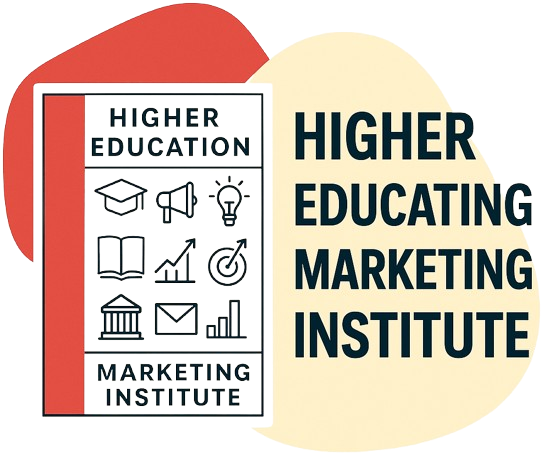Common Themes
- Importance of personalized and authentic communication.
- Use of data-driven strategies and analytics.
- Leveraging digital platforms and social media.
- Emphasis on collaboration and expert involvement.
- Focus on targeted marketing strategies (e.g., industry-specific, job titles).
- Highlighting affordability and financial aid in higher education.
- Use of storytelling and high-quality content.
Surprising Points
- LinkedIn’s introduction of CTV ads for targeting professionals.
- Emphasis on preventing “summer melt” through continuous engagement and support.
- Use of user-generated content in higher education marketing.
- Specific mention of optimizing mobile experiences.
- Incorporating influencer marketing to engage Gen Z.
- Success of a community college’s digital campaign through expert collaboration.

Gen-Z: Mastering Education Marketing for the Digital Natives
Higher Education Marketing
Synopsis:
- The article discusses the characteristics and behaviors of Generation Z (Gen Z) students and provides marketing strategies to effectively reach and engage them in higher education.
- Gen Z students are highly tech-savvy, digitally native, seek authenticity, value diverse experiences, and prioritize educational and career outcomes.
- Gen Z students prefer interactive and personalized digital content, such as videos, social media, and mobile apps, over traditional marketing methods.
- The article highlights the importance of optimizing websites for mobile devices, leveraging social media platforms popular among Gen Z, creating immersive learning experiences, and incorporating influencer marketing.
- Gen Z students prioritize educational affordability and financial aid options, so institutions must promote scholarships, grants, and flexible payment plans.
- Noteworthy positions by the author: Emphasizing the need for personalization, authenticity, and innovative marketing approaches to effectively engage Gen Z students in higher education.
Background resources:
- The article does not include specific background resources.
Takeaways:
- Gen Z students, as digital natives, have unique preferences for interactive and personalized digital content.
- Institutions should optimize their websites for mobile devices and utilize social media platforms popular among Gen Z to effectively reach and engage them.
- Emphasizing authenticity and creating immersive educational experiences can help attract and retain Gen Z students.
- Institutions should promote educational affordability, financial aid options, and flexible payment plans to address Gen Z students’ concerns.
“🎓📲 Engage Gen Z with authentic digital strategies. Optimize sites, use social media, highlight affordability. #GenZ #HigherEdMarketing”
Tweet

Guide to LinkedIn CTV Ads | Carnegie—Higher Ed Marketing & Enrollment
Carnegie—Higher Ed Marketing & Enrollment
https://www.carnegiehighered.com/blog/how-to-use-linkedin-ctv-ads
Synopsis:
LinkedIn, the professional networking platform, has introduced a new feature allowing advertisers to target its audience through Connected TV (CTV) ads. The article discusses how businesses can leverage this feature to reach professionals on the big screen and provides step-by-step guidance on setting up CTV ads on LinkedIn. The author highlights the benefits of using LinkedIn’s CTV ads, such as targeting specific industries or job titles, and the potential for higher engagement with a professional audience. The article also mentions the need to create captivating video content and provides tips on optimizing ads for the CTV experience.
Key Points:
- LinkedIn has launched a new feature for advertisers to utilize CTV ads.
- CTV ads allow businesses to reach a professional audience on LinkedIn via the big screen.
- Step-by-step guidance is provided on setting up CTV ads on LinkedIn.
- LinkedIn’s CTV ads offer benefits like industry and job title targeting.
- CTV ads have the potential to achieve higher engagement with a professional audience.
- Creating compelling video content is essential for successful CTV ads.
- Optimization tips for a seamless CTV ad experience are shared.
Noteworthy Positions/Author’s Perspective:
The author emphasizes LinkedIn’s unique advantage of targeting professionals through CTV ads, providing an opportunity for businesses to connect with a highly relevant audience. The article showcases the step-by-step process and highlights the benefits and best practices to help advertisers effectively leverage LinkedIn’s CTV ad feature.
Summary and Takeaways:
Summary: This article explains how companies can use LinkedIn’s new CTV ad feature to target professionals on the big screen. It provides a detailed guide on setting up CTV ads, mentions the benefits and targeting options available, emphasizes the importance of captivating video content, and offers optimization tips for a seamless CTV ad experience.
Takeaways:
- LinkedIn now offers CTV ads to reach a professional audience.
- Step-by-step instructions for setting up CTV ads on LinkedIn are provided.
- Targeting specific industries or job titles is a unique advantage of LinkedIn’s CTV ads.
- The professional audience on LinkedIn can lead to higher engagement with CTV ads.
- Captivating video content and optimization are crucial for successful CTV ads.
“📺🎯 Reach pros with LinkedIn’s new CTV ads! 🎥 Target industries and job titles for better engagement. Follow the guide. #LinkedIn #CTVAds”
Tweet

2024 Higher Education Marketing Benchmarks: Get Past Your Blindspot
Search Influence
Synopsis:
- The article discusses the importance of higher education marketing benchmarks.
- It emphasizes the need to identify blindspots in marketing strategies and use benchmarks to improve performance.
- The author provides key data and insights to showcase the impact of benchmarks on marketing effectiveness in the higher education industry.
- They highlight the importance of analyzing data, setting realistic goals, and staying up-to-date with industry trends.
- The author encourages higher education marketers to explore innovative strategies, such as incorporating user-generated content and optimizing mobile experiences, to enhance their marketing efforts.
- The article references several external resources, including studies and reports, to support the arguments presented.
Unique/Noteworthy positions:
- The author emphasizes the significance of recognizing blindspots and using benchmarks to overcome them, acknowledging that many marketing professionals have blindspots in their strategies.
- They advocate for a data-driven approach and the use of analytics to measure and improve marketing performance.
- The author suggests innovative strategies, such as utilizing user-generated content and optimizing mobile experiences, to stay ahead in the highly competitive higher education market.
Summary & Takeaways:
- Benchmarking is crucial for higher education marketers to identify blindspots and improve performance.
- Analyzing data, setting realistic goals, and staying informed about industry trends are key to successful marketing strategies.
- Utilizing user-generated content and optimizing mobile experiences can greatly enhance marketing efforts.
- By leveraging marketing benchmarks, higher education institutions can improve their branding, student recruitment, and overall success.
“🎓📊 Overcome blindspots in higher ed marketing! 🚀 Use benchmarks and data to boost performance. 💡 #HigherEducation #MarketingStrategy”
Tweet
CMOLab 2024: Elevating Higher Ed Marketing through Strategy and Experience
insights.simpsonscarborough.com
https://insights.simpsonscarborough.com/cmolab2024-reflections
Synopsis:
- The article is a reflection on the CMOLAB2024 event and its impact on the field of higher education marketing and communications.
- It discusses the key takeaways and insights gained from the event, including discussions on branding, digital strategies, and data analytics.
- The author highlights the importance of collaboration and the need for continuous learning and adaptation in the evolving landscape of higher education marketing.
- The article provides several resources and references for further reading on the topics discussed.
- The author acknowledges the challenges faced by higher education marketing professionals and emphasizes the importance of staying agile and innovative in order to succeed.
Unique or Noteworthy Positions:
- The author emphasizes the role of storytelling and emotional connections in higher education marketing.
- The article promotes the use of data and analytics to drive marketing strategies and measure success.
- The author emphasizes the need for a customer-centric approach and the importance of understanding audience needs and preferences.
Summary and Takeaways:
- CMOLAB2024 brought together higher education marketing professionals to share insights and best practices.
- Key takeaways include the power of storytelling, the importance of data analytics, and the need for collaboration and innovation.
- Higher education marketers should stay agile, customer-focused, and continuously adapt to the evolving landscape.
- Resources and references are provided for further reading on the topics discussed.
“🎓 CMOLAB2024 insights: storytelling, data analytics, collaboration, innovation. Stay agile and customer-centric! #HigherEdMarketing #CMOLAB2024”
Tweet

A Community College’s Digital Marketing Success
Advance Education
https://www.advanceeducation.com/case-study/a-community-colleges-digital-marketing-success
Synopsis:
- The article discusses a case study of a community college that successfully implemented a digital marketing campaign.
- The college’s marketing team used targeted online advertisements, social media marketing, and email marketing to reach prospective students.
- They also focused on creating engaging and informative content on their website, including blog posts and videos.
- The results of the campaign were impressive, with increased website traffic, higher conversion rates, and more applicants.
- The college’s success can be attributed to their strategic approach, data-driven decision making, and collaboration with digital marketing experts.
Background Resources:
- The college’s website and digital marketing platforms
- Data and analytics tools used to measure campaign effectiveness
- Digital marketing experts and consultants
Unique/Noteworthy Positions:
- The college’s marketing team emphasizes the importance of understanding their target audience and tailoring marketing messages accordingly.
- They also highlight the significance of regularly analyzing data to make informed decisions and optimize marketing efforts.
- Collaboration with external digital marketing experts was crucial in developing effective strategies and implementing best practices.
Summary and Takeaways:
- Community colleges can achieve digital marketing success by implementing targeted online advertisements, engaging social media marketing, and informative content creation.
- Understanding the target audience and analyzing data are essential for effective campaign optimization.
- Collaborating with digital marketing experts can provide valuable insights and guidance.
- By leveraging digital marketing strategies, community colleges can increase website traffic, improve conversion rates, and attract more applicants.
“🎓💻 Community college digital marketing: Targeted ads, engaging content, expert collaboration = more applicants! #HigherEd #DigitalMarketing 📈”
Tweet
Increasing Enrollment with Online Video Marketing
Advance Education
https://www.advanceeducation.com/case-study/increasing-enrollment-with-online-video-marketing
Synopsis:
- The article discusses how educational institutions can use online video marketing to attract and enroll more students.
- It highlights the benefits of online video marketing, such as increased engagement, reach, and the ability to showcase the institution’s unique offerings.
- The author provides case studies and examples of successful video marketing campaigns by educational institutions.
- The article also offers tips and best practices for creating effective educational videos, including storytelling, personalization, and high production quality.
- It emphasizes the importance of targeting the right audience and having a clear call to action in the videos.
- The author mentions the use of analytics and tracking to measure the success of video marketing campaigns.
- Background resources cited include industry studies, surveys, and expert opinions on the effectiveness of video marketing in education.
Noteworthy positions taken by the author:
- The author advocates for educational institutions to embrace online video marketing as a powerful tool for boosting enrollment.
- They emphasize the need for creativity and high-quality production in educational videos to stand out from the competition.
- The author highlights the importance of appealing to the emotions and aspirations of potential students through storytelling in videos.
Summary with takeaways:
- Online video marketing can significantly help educational institutions increase enrollment by engaging and attracting more students.
- Educational videos should focus on storytelling, personalization, and high production quality to make a lasting impact.
- Targeting the right audience and having a clear call to action are crucial for the success of video marketing campaigns.
- Measurement and analysis of video campaign performance through analytics and tracking are essential for adjusting and optimizing strategies.
“📹🎓 Boost enrollment with video marketing! Use storytelling, personalization, and quality production. #EducationMarketing #VideoMarketing”
Tweet
Top Strategies to Prevent Summer Melt for Higher Ed-Marketers – Hannon Hill
hannonhill.com
Outline:
- Introduction to the concept of “summer melt” in higher education
- Discussion of the challenges faced by higher ed marketers in preventing summer melt
- Strategies for preventing summer melt:
- Personalized communication and engagement with students
- Utilizing social media and digital platforms
- Implementing summer orientation and transition programs
- Providing resources and support for students
- Importance of collaboration between enrollment management and marketing departments
- Noteworthy positions taken by the author:
- Emphasizes the significance of using data-driven strategies
- Argues for the need to engage students even after they have committed to a college
- Background resources cited:
- American Institutes for Research (AIR)
- National Center for Education Statistics (NCES)
Summary: The article discusses effective strategies for higher education marketers to prevent “summer melt,” where students who have been accepted into a college fail to enroll or withdraw before the start of the academic term. The author highlights the challenges faced by marketers in preventing summer melt and provides strategies such as personalized communication, social media engagement, summer orientation programs, and support resources. Collaboration between enrollment management and marketing departments is emphasized, and the importance of utilizing data-driven strategies is highlighted. The article also argues for continued engagement with students even after their commitment to a college.
Takeaways:
- Summer melt is a significant challenge for higher ed marketers.
- Personalized communication and engagement are key to preventing summer melt.
- Utilizing social media and digital platforms can help maintain student interest.
- Summer orientation programs and support resources can enhance student commitment.
- Collaboration between enrollment management and marketing departments is crucial.
- Data-driven strategies and continued engagement are important in preventing summer melt.
“🎓 Prevent #SummerMelt with personalized communication, social media, and orientation programs. Use collaboration and data strategies! #HigherEd”
Tweet




